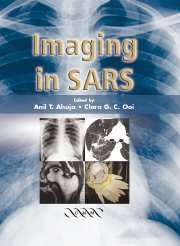Book contents
- Frontmatter
- Contents
- Contributors
- Preface
- 1 The Epidemiology of Severe Acute Respiratory Syndrome: A Global Perspective
- 2 The Role of Emergency Medicine in Screening SARS Patients
- 3 Severe Acute Respiratory Syndrome Outbreak in a University Hospital in Hong Kong
- 4 Imaging of Pneumonias
- 5 The Role of Chest Radiographs in the Diagnosis of SARS
- 6 Chest Radiography: Clinical Correlation and Its Role in the Management of Severe Acute Respiratory Syndrome
- 7 The Role of High-Resolution Computed Tomography in Diagnosis of SARS
- 8 The Role of Imaging in the Follow-up of SARS
- 9 Treatment of Severe Acute Respiratory Syndrome
- 10 SARS in the Intensive Care Unit
- 11 Imaging of Pneumonia in Children
- 12 Imaging and Clinical Management of Paediatric SARS
- 13 Imaging of SARS in North America
- 14 Radiographers' Perspective in the Outbreak of SARS
- 15 Implementation of Measures to Prevent the Spread of SARS in a Radiology Department
- 16 Aftermath of SARS
- 17 Update on Severe Acute Respiratory Syndrome
- Index
11 - Imaging of Pneumonia in Children
Published online by Cambridge University Press: 27 October 2009
- Frontmatter
- Contents
- Contributors
- Preface
- 1 The Epidemiology of Severe Acute Respiratory Syndrome: A Global Perspective
- 2 The Role of Emergency Medicine in Screening SARS Patients
- 3 Severe Acute Respiratory Syndrome Outbreak in a University Hospital in Hong Kong
- 4 Imaging of Pneumonias
- 5 The Role of Chest Radiographs in the Diagnosis of SARS
- 6 Chest Radiography: Clinical Correlation and Its Role in the Management of Severe Acute Respiratory Syndrome
- 7 The Role of High-Resolution Computed Tomography in Diagnosis of SARS
- 8 The Role of Imaging in the Follow-up of SARS
- 9 Treatment of Severe Acute Respiratory Syndrome
- 10 SARS in the Intensive Care Unit
- 11 Imaging of Pneumonia in Children
- 12 Imaging and Clinical Management of Paediatric SARS
- 13 Imaging of SARS in North America
- 14 Radiographers' Perspective in the Outbreak of SARS
- 15 Implementation of Measures to Prevent the Spread of SARS in a Radiology Department
- 16 Aftermath of SARS
- 17 Update on Severe Acute Respiratory Syndrome
- Index
Summary
Introduction
Pneumonia is one of the most common serious infections of childhood. Plain chest radiographs remain the diagnostic mainstay in childhood pneumonia and chest computed tomography (CT) is rarely required in immunocompetent children presenting with symptoms and signs typical of chest infection. The appearance of different kinds of the childhood pneumonia is well established and fully described in the early literature of 1970s and 1980s. Since then, there is no significant further update on the radiographic aspects of childhood pneumonia. The relatively old references are therefore omitted in this chapter.
The major indication of chest radiograph in children presenting with chest infection is to confirm or exclude the presence of pneumonia. A follow-up chest X-ray is not routine in the management of children who have uneventful recovery, as postobstruction pneumonia (secondary to pulmonary carcinoma), which occurs in adults, is not a concern in paediatric age group.
The other indications of imaging, including CT, in children presenting with chest infections are:
to predict or suggest the nature of the infectious agent;
to look for any underlying developmental anomaly that predisposes a child to persistent or recurrent pneumonia;
to assess acute complications and to guide management;
to evaluate the sequelae of respiratory infection.
Chest X-ray and common infective agents
The common aetiological agents that cause lower respiratory tract infection in children vary with age.
- Type
- Chapter
- Information
- Imaging in SARS , pp. 109 - 120Publisher: Cambridge University PressPrint publication year: 2004

